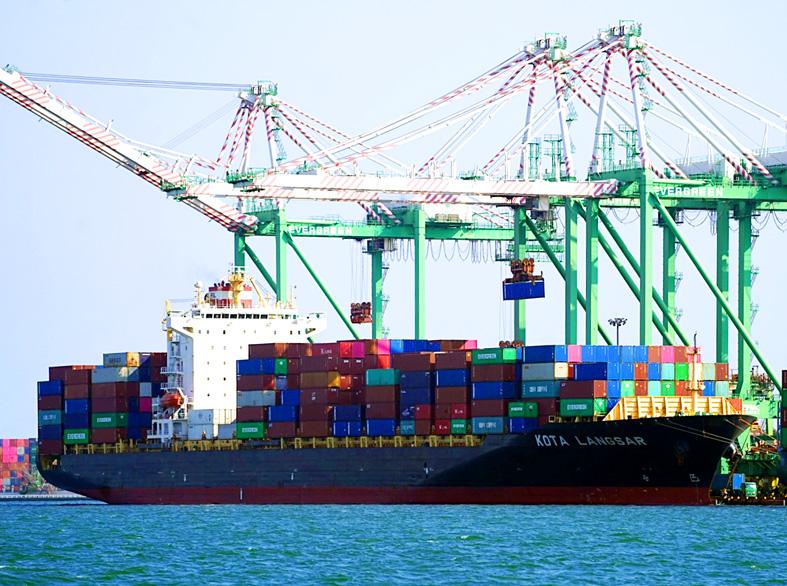Export orders grew for a 16th straight month annually to US$53.75 billion last month, the Ministry of Economic Affairs reported yesterday.
The figure was up 2.8 percent from May and 31.1 percent from a year earlier, it added.
Despite the COVID-19 pandemic, robust global demand for tech products and high commodity prices made last month’s orders the strongest June level on record, Department of Statistics Director Huang Yu-ling (黃于玲) told a news conference in Taipei.

Photo: CNA
For the second quarter, export orders reached US$160.96 billion, up 8 percent from the first quarter and 35.9 percent from a year earlier. That brought orders for the first half of the year to US$309.92 billion, an annual increase of 39.2 percent, the highest for the same period on record, the ministry said.
“The stay-at-home economy has not abated,” Huang said. “The demand for laptops, graphic cards and storage devices remains strong.”
Orders for information and communications technology products grew 6.9 percent year-on-year to US$13.89 billion last month, and those for electronics items increased 36.5 percent to US$16.79 billion, bolstered by demand for 5G and high-performance computing applications, the ministry said.
Orders for optical products expanded 42.7 percent year-on-year to US$2.74 billion last month, driven by demand from China and Hong Kong, it said.
Taiwanese exporters also benefited from the US and EU infrastructure projects, as base metal orders surged 81.8 percent to US$3.32 billion and orders for mechanical products advanced 40 percent to US$2.26 billion, the ministry said.
Orders for plastics and petrochemicals rose 57.5 percent to US$2.6 billion last month, thanks to rising oil prices and increasing demand, while chemical product orders expanded 43.2 percent to US$1.87 billion, it said.
The US was again the biggest source of export orders, which rose 7.8 percent month-on-month and 24 percent year-on-year to US$16.48 billion, it said.
China followed at US$14.43 billion, up 1.5 percent month-on-month and 36.7 percent year-on-year, and the EU came in third with orders of US$9.28 billion, down 2.5 percent month-on-month, but up 24.3 percent year-on-year.
While the pandemic remains an uncertainty, the steady increase in global vaccinations and a pickup in basic infrastructure projects lend confidence to a recovery, Huang said.
“The pace of global economic recovery is picking up, and we are entering into the second half of the year, the strong season for consumer electronic products,” Huang said. “We can expect export orders to stay strong.”
A recent survey of Taiwanese businesses showed that 20.5 percent expect fewer orders for this month, 19.5 percent expect more orders and 60.1 percent expect orders to be flat, the ministry said.
The ministry forecast export orders for this month of US$52.7 billion to US$54.2 billion, down 1.9 percent to 0.9 percent month-on-month, but up 15.7 to 18.9 percent year-on-year.

CHIP RACE: Three years of overbroad export controls drove foreign competitors to pursue their own AI chips, and ‘cost US taxpayers billions of dollars,’ Nvidia said China has figured out the US strategy for allowing it to buy Nvidia Corp’s H200s and is rejecting the artificial intelligence (AI) chip in favor of domestically developed semiconductors, White House AI adviser David Sacks said, citing news reports. US President Donald Trump on Monday said that he would allow shipments of Nvidia’s H200 chips to China, part of an administration effort backed by Sacks to challenge Chinese tech champions such as Huawei Technologies Co (華為) by bringing US competition to their home market. On Friday, Sacks signaled that he was uncertain about whether that approach would work. “They’re rejecting our chips,” Sacks

Taiwan’s long-term economic competitiveness will hinge not only on national champions like Taiwan Semiconductor Manufacturing Co. (TSMC, 台積電) but also on the widespread adoption of artificial intelligence (AI) and other emerging technologies, a US-based scholar has said. At a lecture in Taipei on Tuesday, Jeffrey Ding, assistant professor of political science at the George Washington University and author of "Technology and the Rise of Great Powers," argued that historical experience shows that general-purpose technologies (GPTs) — such as electricity, computers and now AI — shape long-term economic advantages through their diffusion across the broader economy. "What really matters is not who pioneers

BUBBLE? Only a handful of companies are seeing rapid revenue growth and higher valuations, and it is not enough to call the AI trend a transformation, an analyst said Artificial intelligence (AI) is entering a more challenging phase next year as companies move beyond experimentation and begin demanding clear financial returns from a technology that has delivered big gains to only a small group of early adopters, PricewaterhouseCoopers (PwC) Taiwan said yesterday. Most organizations have been able to justify AI investments through cost recovery or modest efficiency gains, but few have achieved meaningful revenue growth or long-term competitive advantage, the consultancy said in its 2026 AI Business Predictions report. This growing performance gap is forcing executives to reconsider how AI is deployed across their organizations, it said. “Many companies

China Vanke Co (萬科), China’s last major developer to have so far avoided default amid an unprecedented property crisis, has been left with little time to keep debt failure at bay after creditors spurned its proposal to push back a looming bond payment. Once China’s biggest homebuilder by sales, Vanke failed to obtain sufficient support for its plan to delay paying the 2 billion yuan (US$283.51 million) note due today, a filing to the National Association of Financial Market Institutional Investors showed late on Saturday. The proposal, along with two others on the ballot, would have allowed a one-year extension. All three